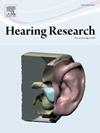使用虚拟教室环境对儿童人工耳蜗用户自动分类器AutoSense Sky OS进行评估
IF 2.5
2区 医学
Q1 AUDIOLOGY & SPEECH-LANGUAGE PATHOLOGY
引用次数: 0
摘要
本研究评估了用于儿童高级仿生学人工耳蜗(CIs)的自动分类器AutoSense Sky OS是否在不显著损害空间意识(即来自各个方向的声音检测和识别)的情况下,从正面提高了语音清晰度,并主要关注教室情况。对12名7-16岁的儿童CI使用者进行了双盲交叉研究。参与者测试了两种设置:一种是激活AutoSense Sky操作系统,另一种是全向麦克风模式。在虚拟教室环境中,使用虚拟现实耳机和12个扬声器阵列评估正面语音清晰度和空间意识。参与者还对每个场景在带回家期间的表现进行了评估。一项技术评估显示,AutoSense Sky OS在虚拟教室中激活了它的定向麦克风模式,在听力测试中显著提高了前排的语音清晰度,同时在空间意识上造成了统计学上显著但很小的降低。虽然并非所有的参与者都报告了日常生活中设置的明显差异,但12个孩子中有8个更喜欢“打开自动感应”。相反,一些参与者更喜欢“关闭自动感应”,因为在“打开自动感应”的情况下,从后面看,定位和语音清晰度较差。综上所述,自动分类器在教室等嘈杂环境下提高了语音理解能力,但代价是空间意识略有下降。CI儿童及其父母对AutoSense Sky OS的偏好似乎是在嘈杂条件下提高语音清晰度和降低空间意识之间的个体权衡问题。本文章由计算机程序翻译,如有差异,请以英文原文为准。
Evaluation of the Automatic Classifier AutoSense Sky OS for pediatric cochlear implant users using a virtual classroom environment
This study evaluated whether AutoSense Sky OS, an automatic classifier used in pediatric Advanced Bionics cochlear implants (CIs), improves speech intelligibility from the front without significantly impairing spatial awareness (i.e., sound detection and identification from all directions), with the main focus on the classroom situation. A double-blind crossover study was conducted with 12 pediatric CI users aged 7–16 years. Participants tested two settings: one with AutoSense Sky OS activated and the other with an omnidirectional microphone mode. Speech intelligibility from the front and spatial awareness were assessed in a virtual classroom environment using a Virtual Reality headset and a 12-loudspeaker array. Participants also rated the performance of each setting during a take-home period. A technical evaluation revealed that AutoSense Sky OS activated its directional microphone mode in the virtual classroom, significantly improving speech intelligibility from the front during the listening test, while causing a statistically significant but small reduction in spatial awareness. While not all participants reported noticeable differences between settings in daily life, 8 out of 12 children preferred “AutoSense on”. Conversely, some participants preferred “AutoSense off” due to poorer localization and speech intelligibility from behind with “AutoSense on”. In conclusion, the automatic classifier provided improved speech understanding in noisy conditions such as a classroom, at the cost of a slightly reduced spatial awareness. The preference for AutoSense Sky OS among CI children and their parents appears to be a matter of individual trade-offs between improved speech intelligibility in noisy conditions and reduced spatial awareness.
求助全文
通过发布文献求助,成功后即可免费获取论文全文。
去求助
来源期刊

Hearing Research
医学-耳鼻喉科学
CiteScore
5.30
自引率
14.30%
发文量
163
审稿时长
75 days
期刊介绍:
The aim of the journal is to provide a forum for papers concerned with basic peripheral and central auditory mechanisms. Emphasis is on experimental and clinical studies, but theoretical and methodological papers will also be considered. The journal publishes original research papers, review and mini- review articles, rapid communications, method/protocol and perspective articles.
Papers submitted should deal with auditory anatomy, physiology, psychophysics, imaging, modeling and behavioural studies in animals and humans, as well as hearing aids and cochlear implants. Papers dealing with the vestibular system are also considered for publication. Papers on comparative aspects of hearing and on effects of drugs and environmental contaminants on hearing function will also be considered. Clinical papers will be accepted when they contribute to the understanding of normal and pathological hearing functions.
 求助内容:
求助内容: 应助结果提醒方式:
应助结果提醒方式:


